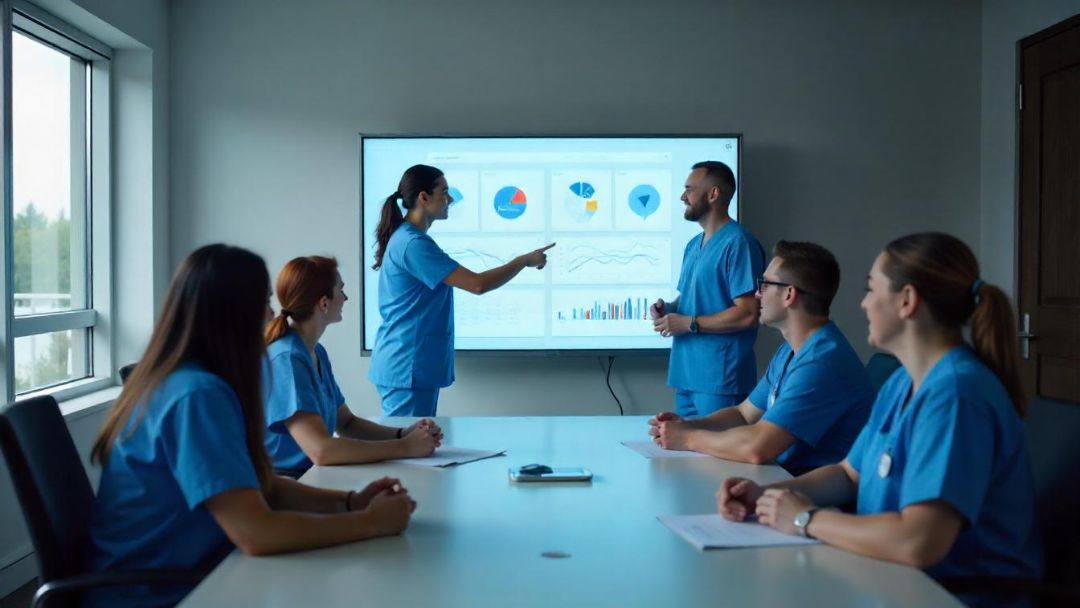Mastering EMR: How to Use EMR Systems

Want to know how to use EMR systems effectively? This guide covers everything you need—from selecting the right software to training your staff and enhancing patient engagement. By the end, you’ll understand how to use EMR systems to boost patient care and streamline your practice.
Key Takeaways
- Effective implementation of EMR systems enhances patient care quality and operational efficiency by integrating customized workflows and clinical protocols.
- Ongoing staff training and support are essential post-implementation to ensure proficiency in EMR usage, foster continuous learning, and maintain high data accuracy.
- Compliance with regulations such as HIPAA and regular audits are critical for safeguarding patient data and ensuring the integrity of EMR systems.
Introduction

The integration of electronic medical record (EMR) systems has become fundamental in advancing patient care and enhancing the efficiency of healthcare operations. Our experience demonstrates that the successful deployment of these EMR systems is pivotal in elevating the standard of care provided to patients. These electronic health record tools are crucial not only for digitizing patient records but also for redefining how we manage our entire electronic health record system.
For the effective application of inpatient treatment, it’s essential that healthcare organizations fully grasp and employ these EMR technologies with a proactive mindset. A thorough appreciation and positive adoption approach toward EMRs can help navigate through any obstacles during implementation, leading to better outcomes for patients while simultaneously simplifying procedural workflows.
Significant advancements have been made in quality control within healthcare services as well as operational effectiveness following the execution of an EMR strategy tailored to align with specific clinical practices and protocols associated with individualized patient needs. It becomes imperative then to investigate opportunities for optimizing setup procedures, customization possibilities, and utilization techniques when considering such critical infrastructure upgrades. Thus, we must make sure that our chosen EMR system evolves beyond being just another tool into becoming a key component integral to our overall model for delivering exceptional medical care.
Setting Up Your EMR System

Establishing an electronic medical records (EMR) system propels your practice toward a state of increased efficiency and patient-centricity. The deployment of EMRs notably bolsters the quality and efficacy of healthcare services. To ensure that this technology complements your clinic’s particular operational methods and patient care protocols, meticulous planning and precise implementation are essential.
Tailoring an EMR system is crucial to molding it into an extension of your clinical approach, allowing for seamless integration with how you manage patient care. By adjusting features and preferences within the system, it can be honed to accommodate unique processes within your practice, thereby facilitating enhanced support for patient-centered care.
The impact that an EHR (Electronic Health Records) system has on medical practices may vary depending on its model type, the context in which it is used, and its interface design, along with user experience considerations.
Selecting the Right EMR Software
Making an informed choice about EMR software is pivotal for the productivity and capability of your medical practice. When evaluating EMR systems, you should take into account their cost-effectiveness, ability to scale with your business needs, integration capabilities with other platforms, and ease of use. These considerations are vital as they enable seamless growth and connectivity within your healthcare system.
A variety of prominent EMR options exist on the market, each offering distinct features to meet diverse demands. For example, one system may provide a robust suite that includes electronic health records (EHR) and tools designed to enhance patient engagement while boasting strong interoperability functions. Another option might present a cloud-based solution recognized for its intuitive interface tailored toward various medical specialties. Conversely, some systems focus on simplifying clinical paperwork alongside enriching both patient engagement practices and revenue management processes. Selecting an option that dovetails well with your specific operational aims is crucial, given the range of functionalities these systems present.
For assistance in matching the most suitable EMR system to individualized clinic workflows or organizational necessities, consult Sequence Health’s personalized advisory services. Tapping into this expertise will facilitate decisions conducive to reaching overarching objectives over time.
Configuring Settings
Adjusting configurations within your EMR system can greatly enhance the efficiency of medical practices. It’s crucial to examine and refine current procedures, identifying any areas where there is waste or duplication before implementing an EMR system. By doing this groundwork, you can tailor a setup that caters directly to the unique requirements of your practice.
It is essential to handle the shift carefully when incorporating a new EMR system in order not to interfere with existing processes. Designating suitable roles and access levels for users is critical for creating effective usage protocols within the EMR system. This strategy guarantees that team members have appropriate access to information while also safeguarding data privacy.
At Sequence Health, we actively involve clinicians during the development stages of our EMR systems, ensuring they correspond with their anticipated workflow patterns. This cooperative effort results in crafting a platform that supports administrative functions and simultaneously improves both clinical operations and patient care outcomes.
Customizing Features
Adjusting the functionalities within your EMR system can enhance clinical workflows by adapting the system to fit the specific requirements of your medical practice. Customizing templates and fields for data entry not only substantially increases operational efficiency but also user-friendliness for healthcare providers.
The employment of dots phrases—character strings that trigger template expansion in electronic medical records—markedly reduces time spent on typing and bolsters productivity. It’s critical to select shortcuts that are easy to remember yet do not interfere with standard typing activities when leveraging these templates.
Such personalization’s refine the process of entering data significantly, thereby boosting the overarching efficacy of operations within a healthcare setting.
Training Your Staff

Unlocking the full potential of an EMR system is contingent upon a well-versed and self-assured staff. Implementing the system in a way that prioritizes patient-centered care will augment their healthcare experience. Achieving this objective can be accomplished through various training methods, including programs offered by vendors, digital learning platforms, practical hands-on instruction, and independent study materials.
In smaller practices where resources may be sparse, ‘EMR champions’ serve as invaluable assets—mentoring colleagues, providing support among peers, and conducting educational sessions to bolster comprehension and proficiency with the new technology.
Encouraging staff to actively seek help when necessary is crucial for ongoing assistance endeavors. It’s imperative to foster an environment of continuous education and support that keeps personnel abreast of novel updates as well as best practices associated with EMR systems usage—thus ensuring these tools are fully leveraged for optimal results.
Role-Specific Training
By concentrating on the particular duties of distinct staff members, tailored training sessions are designed to foster skill enhancement that is pertinent to each individual’s role. This method guarantees mastery over functions crucial to their respective positions, thereby boosting both efficiency and effectiveness throughout the organization.
Continuous Learning and Support
Continuous assistance from Sequence Health promotes unending education, maintaining staff proficiency with the latest features of EMR systems and shifts in healthcare legislation. Following the deployment of an EMR system, Sequence Health provides perpetual aid to enable practices to adjust seamlessly to system enhancements and regulatory modifications. This enduring support secures the sustained value of the EMR as a critical resource.
Persistent backing in mastering EMR usage guarantees endless advancement and progress. The uninterrupted help offered by Sequence Health post-EMR implementation assists medical practices in refining their use of these systems, thereby enhancing patient involvement and bolstering clinical decision-making capabilities.
Efficient Data Entry Practices
In healthcare environments, the practice of efficient data entry is crucial for ensuring both high-quality patient data and heightened operational efficiency. When utilizing EHR systems, it’s vital that collected information is precise to avoid negative impacts on patient care. The implementation of automated checks within these systems verifies the accuracy and thoroughness of entered patient details, reducing errors and bolstering the trustworthiness of their medical records.
The incorporation of clinical decision support tools within EMR platforms furnishes instantaneous recommendations tailored to individual patients’ profiles, thereby improving the standard of care delivered as well as safeguarding against risks associated with patient safety. Fostering better access to care for patients while simultaneously driving optimal financial results underscores a range of advantages derived from proficiently managing EMR system resources.
Thorough training programs significantly advance healthcare providers’ ability to swiftly navigate through an EMR system when entering or consulting critical information such as demographics or appointment histories—thus enhancing overall workflows—and aiding in important processes like report generation. This elevated capacity not only streamlines practitioners’ duties but also fortifies their role in making informed decisions thanks to quick access to essential data points covering various aspects like billing trends.
Using Templates and Shortcuts
The use of templates in EMR systems greatly optimizes the process of entering routine data. By enhancing the efficiency of data entry at patient visits, these templates minimize mistakes and save time. Consequently, healthcare providers can devote more attention to providing care to patients rather than dealing with administrative duties, leading to increased patient satisfaction.
Ensuring Data Accuracy
Within EMR systems, the integration of validation tools serves to identify and correct entry errors, thereby improving data quality. By implementing regular data verification practices such as utilizing checkboxes and drop-down menus, the fidelity of information input into EMRs is preserved. These steps are vital in guaranteeing that patient records are dependable and precise—factors essential for delivering high-quality patient care.
Before finalizing entries within an EMR system, it’s crucial to perform a thorough review of the data to minimize inaccuracies, which enhances the trustworthiness of patient records. To promote accuracy in documenting vital sign measurements, these systems employ methods like audit trails, integrity checks, and established validation rules. Mitigating potential human mistakes and inconsistencies regarding measurement units contributes significantly to sustaining superior data quality within these systems. This underpins improved clinical outcomes for patients.
Enhancing Patient Engagement

EMR systems play a crucial role in bolstering patient engagement, thereby improving both satisfaction and healthcare outcomes. By granting patients access to their own medical history and details regarding their treatment plans, these systems empower individuals to actively participate in managing their health, which can lead to more favorable results.
The implementation of automated reminders for appointments through EMR platforms is instrumental in reducing no-shows. This increase in appointment adherence elevates patient engagement and contentment with the care received. Such an enhancement in engaging patients when utilizing EMRs not only promotes greater satisfaction but also aids significantly in advancing the overall quality of healthcare provision and ensuring higher standards of patient safety.
Patient Portal Integration
EMR systems enhanced with patient portals provide a simple way for individuals to access their health information and coordinate appointments. Such integration promotes improved accessibility to healthcare data, enabling patients to manage their schedules seamlessly without the necessity of telephone contact with the provider’s office.
These patient portals establish an avenue for immediate interaction between healthcare providers and patients, thereby boosting engagement levels. Through this direct communication channel, patient inquiries can be dealt with swiftly, which greatly contributes to elevating both satisfaction rates and health outcomes in pursuit of optimized patient satisfaction.
Secure Messaging
Efficient communication between providers and patients within EMR systems is bolstered by secure messaging, which not only expedites response times but also guarantees the safe exchange of sensitive patient information. By maintaining confidentiality, secure messaging builds trust and promotes greater patient engagement.
Managing Clinical Data
Enhanced management of clinical data leads to improved accuracy in patient information and a reduction in medical mistakes. The adoption of an EHR system considerably benefits healthcare organizations by ensuring that patient data is both accurate and readily available, which bolsters clinical decision-making processes and elevates the standard of patient care.
Poorly structured data can compromise the integrity of data quality, raising the risk of reduced-quality records and incomplete information. Incorporating more structured entries into Electronic Medical Records (EMRs) improves how effectively clinical registries can be utilized, enriches clinical workflows, and aids in better monitoring quality metrics. Confronting these challenges guarantees dependable clinical data that underpins high-quality patient care delivery.
Handling Laboratory Data
Managing laboratory data within EMR systems requires the seamless incorporation of information from independent laboratories, along with prompt and precise record input. To access certain laboratory results in EMRs, clinicians must sometimes initiate importing procedures that could postpone their availability. Such delays can cause inefficiencies and possible lapses in providing patient care.
The ability to exchange EHR-derived lab data across multiple sites is hindered by dependence on unique local coding schemes. The adoption of standardized codes like LOINC can aid in normalizing how laboratory data are reported throughout different healthcare settings. Enhanced interoperability, as a result, allows healthcare providers to improve both the precision and easy retrieval of lab information for better patient management.
Monitoring Vital Signs
Tracking patient health and ensuring timely healthcare interventions are critically dependent on diligent monitoring of vital signs within an EMR system. Vital sign data embedded in electronic health records typically include measurements such as height, weight, body mass index (BMI), pulse rate, blood pressure, respiratory rate, and temperature—all pivotal for delivering effective care to patients.
Several factors can compromise the quality of vital sign information derived from EHRs. Such issues may stem from human entry errors inconsistencies in units used for measurement, or a lack of essential metadata accompanying these recordings. EMR systems possess built-in tools like validation rules and audit trails that work towards maintaining clinical data integrity by checking against inaccuracies.
Confronting these challenges head-on is imperative for healthcare providers who aim to leverage accurate vital sign data culled from EHRs as they strive to deliver high-quality care tailored specifically to their patient’s needs.
Reporting and Analytics
Implementing electronic medical record (EMR) systems in primary care can yield substantial financial and operational advantages, with an anticipated net financial gain of $86,400 per provider over a span of five years.
Key benefits stemming from the use of EMR systems include reductions in medication costs and enhanced efficiency in the use of radiology exams. These systems facilitate more accurate billing by improving charge capture and reducing errors related to billing processes.
Generating Reports
Healthcare providers can leverage the ability to create specialized reports within EMR systems to observe critical performance metrics closely and improve patient outcomes. Tracking a range of indicators, from patient records to radiology reports, these custom reports yield crucial data that aids in making well-informed choices and fosters initiatives aimed at enhancing quality.
Utilizing Analytics Tools
EMR systems come equipped with analytics tools that allow healthcare providers to spot trends and make knowledgeable decisions, thus advancing initiatives aimed at improving quality. These utilities assist in pinpointing trends within patient care, enabling data-informed choices crucial for delivering high-quality patient care while boosting operational efficiency.
In EMR software, the presence of data visualization tools eases the complexity of interpreting intricate datasets by translating them into graphical formats. This simplification ensures that critical information is more approachable and intelligible for healthcare providers, strengthening their capacity to scrutinize and respond effectively to vital data. Consequently, this enhancement supports Improvements in both patient outcomes and the efficiency of operations.
Compliance and Security

Maintaining compliance with EMR standards is crucial to avoid legal complications and preserve the integrity of patient data. It’s imperative that security protocols are in place to safeguard confidential patient information, as this upholds their trust and ensures their safety.
To ensure such goals are met, it is vital to enforce stringent data protection strategies and carry out frequent inspections. This not only bolsters security but also reinforces the commitment to responsible handling of sensitive health records.
HIPAA Compliance
To maintain the confidentiality and security of patient health information, which are vital for delivering high-quality patient care and maintaining trust, healthcare organizations need to establish certain policies that bring their EMR (Electronic Medical Records) systems in compliance with HIPAA (Health Insurance Portability and Accountability Act) regulations. Following these protocols as per HIPAA is essential because it lays down guidelines for safeguarding sensitive patient data.
Data Security Measures
Conducting routine examinations is essential for maintaining adherence and pinpointing any possible compromises in the security of patient records. These evaluations assist healthcare systems in recognizing and rectifying weaknesses, which safeguards the confidentiality of patient data. Implementing protective strategies like encryption and regulating who can access information is fundamental to shielding delicate patient details from unwarranted intrusion and violations.
These security protocols not only safeguard personal health information but also uphold a high standard of data quality. By impeding illegitimate entry points and diminishing breach risks, these tactics ensure that patient documents remain precise, reliable, and protected. Upholding this level of record integrity is vital for preserving both patients’ welfare as well as their confidence in medical care institutions.
Sequence Health’s Role in EMR Implementation
Sequence Health is pivotal in aiding healthcare providers with the adoption and integration of EMR systems to improve patient care and boost operational efficiency.
Their proficiency extends to a spectrum of patient conversion enhancements, including:
- Crafting websites
- Elevating search engine visibility
- Executing digital marketing strategies
- Overseeing social media platforms
Such an inclusive strategy permits healthcare providers to concentrate on top-notch patient services while Sequence Health oversees technicalities and office management tasks.
Sequence Health excels in lead generation by analyzing target markets, pinpointing potential clients, and publicizing medical practices through diversified commercial avenues. This specialized method allows for increased connection with ideal patient demographics, which enhances both engagement levels among patients as well as their overall satisfaction. Notably, one client witnessed a significant surge in new patients upon partnering with Sequence Health—a testimony to their impactful tactics.
Through bespoke consulting and steadfast ongoing support, Sequence Health guarantees that healthcare providers can perpetually realize value from their EMR system investments. Such enduring assistance facilitates adaptability amidst evolving health service demands, ensuring that operations remain streamlined. This leads not only to improved quality but also better outcomes regarding patient care.
Personalized Guidance
Sequence Health provides customized assistance to healthcare providers in selecting and setting up the optimal EMR system tailored to their unique requirements. They evaluate several aspects, such as the size of the practice, its specialty, and particular operational demands during the selection process. By doing so, Sequence Health ensures that the chosen EMR system complements existing workflows within a practice and promotes enhanced efficiency.
Beyond just helping with setup, Sequence Health delivers continuous support post-implementation. Its commitment is to assist practices in reaping ongoing advantages from its EMR systems while adjusting to evolving healthcare needs. With this sustained backing, practices are better equipped to sustain proficient operations and provide high-quality patient care.
Ongoing Support
Healthcare providers receive essential support from Sequence Health to continuously refine their use of EMR systems, which is crucial as the demands within healthcare practices evolve. This provider ensures that staff have access to ongoing education so they can stay current with the most recent developments and established methods for effective EMR application. Such sustained backing assists practices in fully leveraging their EMR system capabilities while upholding superior patient care standards.
Sequence Health’s consistent support equips healthcare professionals with the tools needed to progressively advance their proficiency in employing EMRs, thereby elevating both patient care and operational effectiveness. Support services include frequent system updates and educational workshops, as well as aid with resolving any issues that arise—features that all serve to cement the status of an organization’s EMR system as a key resource.
By offering opportunities for continuous learning through Sequence Health’s efforts, staff members are empowered to swiftly assimilate new functionalities into practice alongside emerging best-practice guidelines. It is this type of persistent assistance that plays a pivotal role in ensuring smooth operations within medical practices while guaranteeing the delivery of high-quality care for patients.
Summary
Healthcare providers must become proficient with EMR integration systems to improve patient care and increase operational efficiency. The meticulous process of selecting, configuring, and customizing the appropriate software is pivotal for an EMR system to meet the specific demands of a practice. Comprehensive training for staff and ongoing support maximizes user adoption, which translates into enhanced patient outcomes and more efficient workflows.
EMR systems are key in fostering patient engagement by offering features such as secure messaging platforms and patient portals—these tools heighten both health outcomes and satisfaction among patients. Through effective management of clinical data that includes generating insightful reports and leveraging analytics tools, healthcare professionals can make well-informed decisions while upholding superior data quality standards. Strict compliance protocols coupled with robust security measures ensure that sensitive patient information is securely maintained within these systems—a critical factor in establishing trustworthiness amongst patients regarding their privacy rights. With professional guidance from organizations like Sequence Health at hand to aid implementation endeavors, it’s possible for healthcare providers to elevate their use of EMRs efficiently towards dispensing top-tier medical care services.
Frequently Asked Questions
What is the importance of EMR systems in healthcare?
EMR systems are crucial in healthcare as they significantly improve patient care and operational efficiency through enhanced data accuracy and accessibility. By streamlining administrative tasks and providing real-time access to patient information, they facilitate better clinical decision-making and lead to improved patient outcomes.
How can Sequence Health assist with EMR implementation?
Sequence Health provides customized support and ongoing assistance for EMR implementation, enabling healthcare providers to focus on providing top-tier care as they handle the technical and administrative aspects with ease.
What are the benefits of integrating patient portals with EMR systems?
Integrating patient portals with EMR systems enhances patient engagement and satisfaction by providing easy access to health information, appointment management, and direct communication with healthcare providers.
This integration ultimately leads to improved health outcomes for patients.
Why is ongoing support important in EMR implementation?
Continuous support plays a pivotal role in the successful implementation of an EMR system, aiding healthcare staff to adjust to changing medical requirements and ensuring they become adept at using newly integrated functionalities.
Such relentless backing significantly boosts the functionality of the EMR system, leading to improvements in patient care quality.





